Gallery
- Virgin and Child Flanked by Sts Benedict and Quentin, 1500-05, Musée du Louvre, originally from San Quintino, Parma
- Leaf from Rangoni Bentivoglio Book of Hours, ca. 1505, Walters Art Museum
Francesco Marmitta (ca. 1460-1505) was an Italian painter and jeweler. Marmitta was born in Parma, Italy, between 1462 and 1466. [1] [2] His father was a merchant of wool and wax. [2] His work is held in the collections of the Metropolitan Museum of Art and the Walters Art Museum. [3] [4]
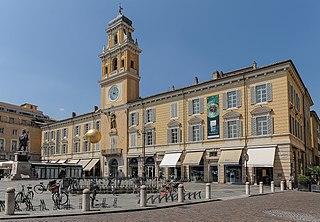
Parma is a city in the northern Italian region of Emilia-Romagna known for its architecture, music, art, prosciutto (ham), cheese and surrounding countryside. With a population of 198,292 inhabitants, Parma is the second most populous city in Emilia-Romagna after Bologna, the region's capital. The city is home to the University of Parma, one of the oldest universities in the world. Parma is divided into two parts by the stream of the same name. The district on the far side of the river is Oltretorrente. Parma's Etruscan name was adapted by Romans to describe the round shield called Parma.
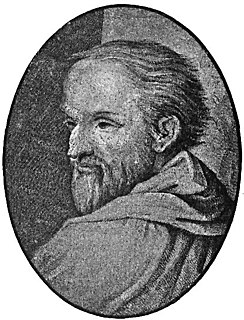
Antonio Allegri da Correggio, usually known as just Correggio, was the foremost painter of the Parma school of the High Italian Renaissance, who was responsible for some of the most vigorous and sensuous works of the sixteenth century. In his use of dynamic composition, illusionistic perspective and dramatic foreshortening, Correggio prefigured the Baroque art of the seventeenth century and the Rococo art of the eighteenth century. He is considered a master of chiaroscuro.
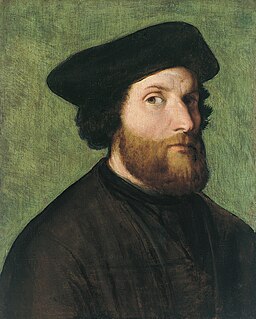
Lorenzo Lotto was an Italian painter, draughtsman, and illustrator, traditionally placed in the Venetian school, though much of his career was spent in other north Italian cities. He painted mainly altarpieces, religious subjects and portraits. He was active during the High Renaissance and the first half of the Mannerist period, but his work maintained a generally similar High Renaissance style throughout his career, although his nervous and eccentric posings and distortions represented a transitional stage to the Florentine and Roman Mannerists.
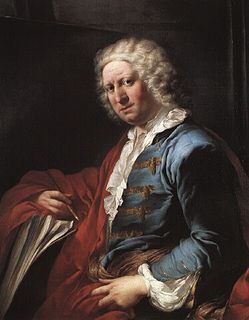
Giovanni Paolo Panini or Pannini was a painter and architect who worked in Rome and is primarily known as one of the vedutisti. As a painter, Panini is best known for his vistas of Rome, in which he took a particular interest in the city's antiquities. Among his most famous works are his view of the interior of the Pantheon, and his vedute—paintings of picture galleries containing views of Rome. Most of his works, especially those of ruins, have a fanciful and unreal embellishment characteristic of capriccio themes. In this they resemble the capricci of Marco Ricci. Panini also painted portraits, including one of Pope Benedict XIV.

LudovicoCarracci was an Italian, early-Baroque painter, etcher, and printmaker born in Bologna. His works are characterized by a strong mood invoked by broad gestures and flickering light that create spiritual emotion and are credited with reinvigorating Italian art, especially fresco art, which was subsumed with formalistic Mannerism. He died in Bologna in 1619.

Francesco Francia, whose real name was Francesco Raibolini was an Italian painter, goldsmith, and medallist from Bologna, who was also director of the city mint.
Andrea Solari (1460–1524) was an Italian Renaissance painter of the Milanese school. He was initially named Andre del Gobbo, but more confusingly as Andrea del Bartolo a name shared with two other Italian painters, the 14th-century Siennese Andrea di Bartolo, and the 15th-century Florentine Andrea di Bartolo.

Girolamo Francesco Maria Mazzola, also known as Francesco Mazzola or, more commonly, as Parmigianino, was an Italian Mannerist painter and printmaker active in Florence, Rome, Bologna, and his native city of Parma. His work is characterized by a "refined sensuality" and often elongation of forms and includes Vision of Saint Jerome (1527) and the iconic if somewhat anomalous Madonna with the Long Neck (1534), and he remains the best known artist of the first generation whose whole careers fall into the Mannerist period.

Girolamo Savoldo, also called Girolamo da Brescia was an Italian High Renaissance painter active mostly in Venice, although he also worked in other cities in northern Italy. He is noted for his subtle use of color and chiaroscuro, and for the sober realism of his works, which are mostly religious subjects, with a few portraits. His portraits are given interest by their accessories or settings; "some even look like extracts from larger narratives".

Sebastiano Ricci was an Italian painter of the late Baroque school of Venice. About the same age as Piazzetta, and an elder contemporary of Tiepolo, he represents a late version of the vigorous and luminous Cortonesque style of grand manner fresco painting.

The Galli-Bibiena family, or Galli da Bibiena, was a family of Italian artists of the 17th and 18th centuries, including:
The decade of the 1460s in art involved some significant events.

Federico Zeri was an Italian art historian specialised in Italian Renaissance painting. He wrote for the Italian newspaper La Stampa, and was a well known television-personality in Italy.

Cristoforo Caselli, also known as Da Palma or il Temporello or Cristofaro Castelli, was an Italian painter of the Renaissance period.

Charles de Cossé, comte de Brissac, was a French courtier and soldier, named beau Brissac at court and remembered as the Maréchal Brissac. A member of the nobility of Anjou, he was appointed in 1540 to his father's prestigious former post of Grand Falconer of France, one of the Great Officers of the Maison du Roi. This was not purely honorary, as the king still hunted with falcons. Brissac was also Grand Panetier, and his position as colonel general of the cavalry (1548–49) was a court appointment. Raised to Marshal of France in 1550, he was Grand Master of the Artillery. He was eventually given the title of Count of Brissac. His son, Charles II de Cossé, became the first Duke of Brissac.

Portrait of a Collector is a painting by the Italian Mannerist artist Parmigianino, executed around 1524.
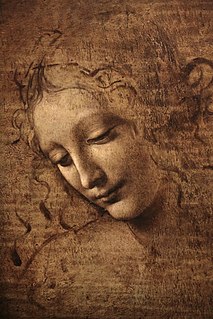
La Scapigliata is an unfinished painting generally attributed to the Italian High Renaissance artist Leonardo da Vinci, and dated c. 1506–1508. Painted in oil, umber, and white lead pigments on a small poplar wood panel, its attribution remains controversial, with several experts attributing the work to a pupil of Leonardo. The painting has been admired for its captivating beauty, mysterious demeanor, and mastery of sfumato.

Federico Di Francesco is an Italian footballer who plays as a winger for Serie A club Empoli.
Francesco Rapisarda is an Italian footballer who plays as a defender for Serie C Group A club Triestina.

Giovanni Francesco Maineri or Gianfrancesco de' Maineri was an Italian painter of the Renaissance, active in Ferrara.
| Wikimedia Commons has media related to Francesco Marmitta . |